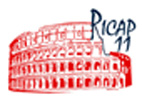Speaker
Mr
Benjamin Fuchs
(Karlsruhe Institut für Technologie, KIT)
Description
The Auger Engineering Radio Array (AERA) is being deployed at the Pierre Auger Observatory in Argentina. AERA is designed as a 20 km$^{2}$ radio array with 160 autonomous radio detection stations to measure the radio emission from ultra-high energetic cosmic ray air showers above $10^{17}$ eV. AERA is based on experiences made with various prototype radio stations at the Pierre Auger Observatory during recent years. In the current stage one, AERA consists of 21 radio antennas operating since November 2010. Because AERA is positioned inside the surface detector array of the Pierre Auger Observatory, coincident measurements with the fluorescence telescopes and surrounding surface detectors are possible. In addition AERA overlaps with the AMIGA and HEAT low energy extensions of the Observatory.
The expected precise measurements will provide insights on the radio emission mechanism and the lateral distribution of radio signals from air showers.These measurements may lead to a better understanding of the emission mechanisms and the intrinsic capabilities of the radio detection technique enabling detailed analyses on the properties of high energetic cosmic rays, like the composition of the primary particles, its energy and the incident direction. In addition, AERA will serve as a prototype for even larger future antenna arrays. AERA acts as the pathfinder for radio antenna arrays on scales of some 1000 km$^{2}$.
We will present the current status, the hardware setup and the first data taken during the commissioning phase of AERA as well as the features of the analysis software developed for AERA. In addition, an outlook on the future of AERA and the foreseen enlargements will be presented.
Primary author
Mr
Benjamin Fuchs
(Karlsruhe Institut für Technologie, KIT)

